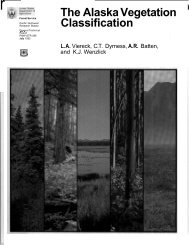Indirect gradient analysis - Alaska Geobotany Center
Indirect gradient analysis - Alaska Geobotany Center
Indirect gradient analysis - Alaska Geobotany Center
You also want an ePaper? Increase the reach of your titles
YUMPU automatically turns print PDFs into web optimized ePapers that Google loves.
Interpreting the ordination diagram<br />
• The axes of the ordination are <strong>gradient</strong>s of floristic similarity (in the case of quadrat<br />
ordinations) or <strong>gradient</strong>s of plot-occurrence similarity (in the case of species<br />
ordinations).<br />
• The results of ordination can be displayed one, two or three dimensions which define<br />
the ordination space.<br />
• In general, the axes produced by ordination <strong>analysis</strong> come out in descending order of<br />
importance. The first axis is most important and describes the most variation in the<br />
floristic data.<br />
• A powerful attribute of plot ordinations is that the plot numbers can be replaced with<br />
species cover values or environmental data to portray trends of environmental<br />
variables or species cover within the ordination space.
















